It is not easy for Catherine and I to find a new place to paddle and
bivouac which is relatively close to Toronto, does not require portaging, has
parking facilities and is relatively safe to canoe. Having talked to a number
people and examining maps and books, we finally decided to try an area close to
Georgian Bay.
On July 27, 2014, we left Toronto and one hour later stopped at Barrie’s
MEC (Mountain Equipment Co-op) store. I was surprised that the store did not
carry topographical maps anymore. Our second stop was at Pointe au Baril and I
when I entered into the LCBO store, it closed its door for the day, it was 4:00
pm. We bought beer and wine; the latter turned out to be not good at all. After
a short drive we arrived at Bayfield Inlet; amazingly, the parking was still
free—but only this year; according to posted signs, as of 2015, we will have to
park at nearby marinas or other private establishments. It was quiet and we did
not see anybody around, so we quickly launched the canoe and soon were paddling
towards Georgian Bay. It was windy, but the numerous islands around provided
ample protection against the wind. Of course, we were paddling against the
wind—during our trips, we paddle against the wind at least 80% of the time and
I do not remember when was the last time we were pushed by strong winds.
Then we turned right and headed towards the River—despite the fact that we
changed the direction, the wind was blowing in our faces!
“We don’t even need a GPS,” I said, “all we
have to do is paddle against the wind and we’ll certainly get to our
destination!”
There were cottages on some islands and along the shores, but as we got
closer to the river, they became quite sparse. The mouth of the
river—consisting of a narrow entrance—was constricting and shallow, with many
rocks sticking out or hiding just under the water, some still bearing traces of
boats’ paint. Almost immediately we found ourselves in a different world! No
traces of human habitation, just graceful rocks and vegetation on both shores.
Soon we reached a sturdy beaver dam. A water snake, sunbathing on the dam, was
staring directly at Catherine and she was afraid it would suddenly jump into
the canoe and attack her. Going over the dam would require us to remove
everything from the canoe—being much too slothful, we turned back and began
looking for a suitable place to set up a bivouac by the river. The east shore
was very rugged, the west shore steep, with rock polished by receding glaciers.
We came ashore—there were perfect sites for a campsite on the top of the rocks,
yet we would have to carry our equipment up—which we did not want to do.
Finally we decided to set up the tent on a sloping rock near the water, which
was not the ideal location, but at least we would not have to walk up and down
steep and smooth rocks; in case it rained, our path would resemble a very
slippery slide. At that point I realized that I did not properly secure the
canoe and it slowly floated away several meters from the shore. Right away I
took my clothes off and swam to get it—besides, it was a great idea to have a
quick bath! Before 9:00 pm we had a campfire and grilled ribs. Mosquitoes were
terrible. One of our folding chairs collapsed and we had to patch it up. It got
quite windy at night and I did not sleep well.
It was still breezy when we got up and some of our bags were blown into
the water. Yesterday we had seen plenty of blueberry bushes with multitude of
big, ripened blueberries. We spent about 30 minutes collecting them and each of
us brought a big cup full of big, sweet, delicious blueberries and probably ate
more than that. We did not need any breakfast. By the way, we decided not to
hang our food—the trees were on the top of the rocky shores and most of them
were quite small and fragile, making it very difficult to hang a big, heavy
barrel.
After the blueberry breakfast we paddled up the river, carried the canoe
over the beaver dam and found ourselves on a beautiful, pristine lake—its
shores were formed of plenty of rocks and rocky hills and large patches of the
lake were literally covered with water lily plants and flowers. It was very
windy; amazingly, the wind pushed us this time towards the west (dead) end of
the lake, where was spotted another beaver dam. But if we thought we were lucky
this time, we were totally mistaken: paddling back, against the strong wind,
turned out to be very strenuous, we moved 2-3 km/h, but it was not a long
paddle and in no time we reached ‘our’ beaver dam, went over it and got back to
our campsite. I spent another 30 minutes collecting blueberries and became
satiated in no time.
In the evening we grilled the last of our ribs over the campfire—we had
our supper earlier to avoid the swarms of mosquitoes which appeared later in
the evening. Before turning in, we listened to the news: it was mostly about
the war in Gaza and problems at the site of the Malaysian plane crash in
Ukraine.
July 30, 2014, Tuesday. In the morning Catherine heard some rustling
just around the tent and water splashing, but we assumed it was beavers,
muskrats or, unlikely, deer. Around 10 am, while we were still in the tent, we
heard lumbering near the tent and then splashing, as if something waded in the
water. Because we had everywhere seen plenty of (probably) moose droppings, we
thought that it was a moose crossing the river. Catherine got out of the tent
and was intensely looking for a moose—so intensely that she almost missed a
black bear, sitting on a rock on the opposite shore and staring at her, like
the water snake from 2 nights before. I quickly left the tent and saw it too,
but by the time I got my camera, the bear was slowly loping into the woods.
Later we tried to figure out where it crossed the water and looking at the
still wet rock, we determined that most likely it utilized a well-used water
passage among the bulrushes that led to the other side of the river—and which
passed just a few meters from our tent!
The weather was so-so, on the cool side: cloudy, with some very light
rain and possible thunderstorms. We decided to stay put on our campsite and
read books. I spent almost one hour picking blueberries and without
exaggeration I must have eaten over one liter of them, they were big and
plentiful. While getting engrossed in blueberry picking, just in case I was
singing or mumbling something aloud—I did not want to startle a hungry bear who
might be also enwrapped in the same activity! The evening news was about
problems in Libya and the evacuation of the Canadian embassy.
Next day we again carried the canoe over the beaver dam and paddled to
the North/Middle Channel—we were surrounded by total solitude, no human-made
structure was in sight, only occasional old fire pits on the rocks indicated
that people do infrequently visit this lake. It was simply magical! According
to our maps, there was a connection to the other body of water, but if there
was, it was totally overgrown with weeds, vegetation and possibly blocked by
beaver dams. So we just paddled, completely alone, reveling in the utmost
beauty, serenity and wilderness that encircled us. There were a few beaver
lodges, some probably abandoned. Around one of them we spotted mysterious gel
blobs, which appeared out of this world—neither of us had ever seen anything
like that before! Later I conducted some research and determined that the
gelatinous balls were called bryozoans. They were tiny colonial animals that
form jelly like masses, often attached to other objects (pieces of wood,
docks). Supposedly fresh water bryozoans are harmless to humans.
By the way, we saw and/or heard bears crossing the
river every day, no more than 30 meters from our campsite, but they were so
silent and discreet that I never had a chance to snap a photo of them—and I did
keep my cameras nearby! Sometimes we saw a black contour on the rock or heard
water splashing—when we looked, all we could see was the rear part of a bear
quickly disappearing in the woods.
One day we left the campsite for the whole day and
paddled on the bay leading to Georgian Bay. There were a few motor boats, some
islands had impressive cottages and the whole area was quite picturesque. When
we came back to the campsite, we did not see anything amiss—apparently bears
were very timid and not interested in our campsite. As we were unable to hang
the food, usually we took the food barrel with us while canoeing.
Altogether we spent 5 nights camping on this lovely
river and we did not see one (human) soul in that area, just about 10 black
bears. We left on Friday, August 1, 2014 and leisurely paddled back to the
dock. [Incidentally, it was the 70th anniversary of the Warsaw
Uprising which broke out on August 1, 1944 and lasted for 63 days. Somehow I
remembered that on the same day 20 years ago, a friend of mine and I had gone
camping to Six Mile Provincial Park and after a short wait, we got the last
(and worst) available site in the park].
As we were unloading the canoe, two kayakers were just ready to depart on their weekend jaunt; they got quite a scare when we told them about the numerous bears at our campsite! On the way back we visited a tourist lodge—and since there were blueberry bushes with tons of big, ripe blueberries along the road, we stopped and in no time our empty 4 liter water containers were full! Locals said it was an amazing year for blueberries due to perfect weather and swarms of black flies which supposedly helped pollinate blueberries. I visited the same place, at the same time of the year, the following year and because of the hot and sunny weather, most of the blueberry bushes were burned by the sun and dry and we only managed to pick a handful of semi-edible blueberries.
As we were unloading the canoe, two kayakers were just ready to depart on their weekend jaunt; they got quite a scare when we told them about the numerous bears at our campsite! On the way back we visited a tourist lodge—and since there were blueberry bushes with tons of big, ripe blueberries along the road, we stopped and in no time our empty 4 liter water containers were full! Locals said it was an amazing year for blueberries due to perfect weather and swarms of black flies which supposedly helped pollinate blueberries. I visited the same place, at the same time of the year, the following year and because of the hot and sunny weather, most of the blueberry bushes were burned by the sun and dry and we only managed to pick a handful of semi-edible blueberries.
Late afternoon we stopped in Parry Sound, visited the
Hart Store and No Frills, bought some food supplies and headed to the main
docks, where we had lunch under the CPR railway trestle over the Sequin River.
The trestle was completed in 1907. Tom Thomson, the famous painter and
precursor of the Group of Seven, had visited Parry Sound in July, 1914—almost
exactly 100 years ago—and painted the bridge and the Parry Sound Lumber
Company; the reproduction of his painting was on a plaque near the trestle.
Trestle at Parry Sound, 1914
Tom
Thomson paddled into the mouth of the Seguin River one evening in mid-July,
1914. He had come from Go Home Bay, stopping to stay in the South Channel for a
few days. Seeing the new CPR trestle, the longest bridge east of the Rockies,
and the Parry Sound Lumber Company aglow in the setting sun, he selected one of
his 8” by 10” wooden boards, and made this evocative sketch in less than an hour.
Today
Tom Thomson is acknowledged as Canada’s foremost painter. Those small wooden
boards he gave to friends can be worth more than a million dollars.
What
he saw in 1914: Fifty years after the lumbering began, logs, arriving down the
river, are trimmed and cut into the mills. The river is dammed; both shores are
lined with tramways, thousands of boards feet of lumber piled high, waiting to
be loaded in ships. The lumber goes to railheads around the Great Lakes to
build the cities of North America and the world. Seven years later, the last of
the mills had burned to the ground, and Parry Sound had welcomed the first of
the cruise ships with visitors to enjoy the natural beauty of the area.
Incidentally, in August, 2015 I was trying to locate
the plaque and show it to my friend, but could not find it—supposedly it had
been vandalized!
Although it was a rather short trip, we will remember
it for a long time: the area was absolutely pristine and extremely picturesque,
unspoiled by any visible human activity. We were able to experience total
solitude, interrupted only by ephemeral sightings of black bears and never
before had we gorged on so many wild blueberries! I am certain that it was not
our last visit there.
Blog po polsku/Blog in the Polish language: http://ontario-nature-polish.blogspot.ca/2015/11/biwakowanie-na-przepieknej-rzece-koo.html



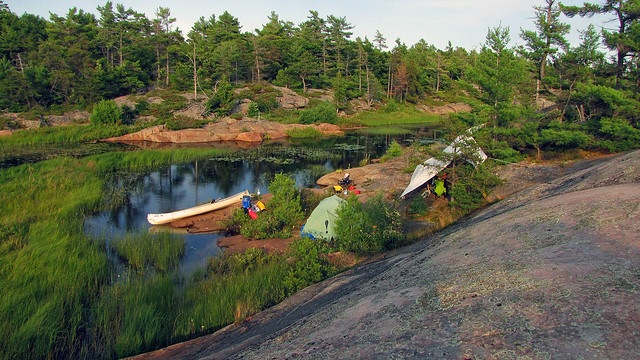
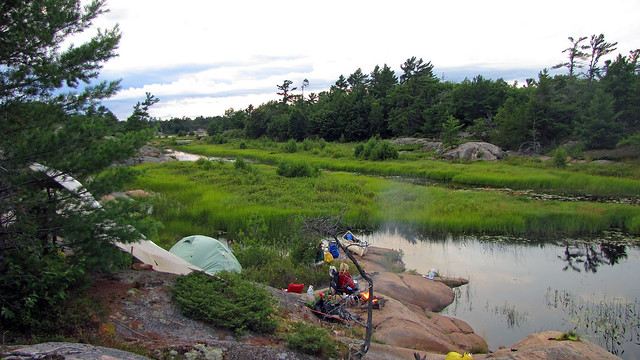
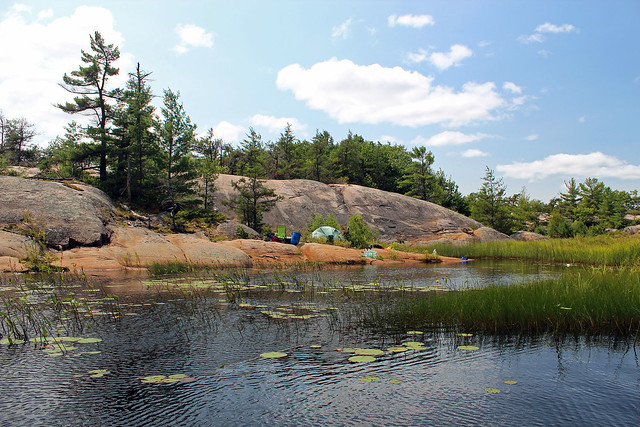


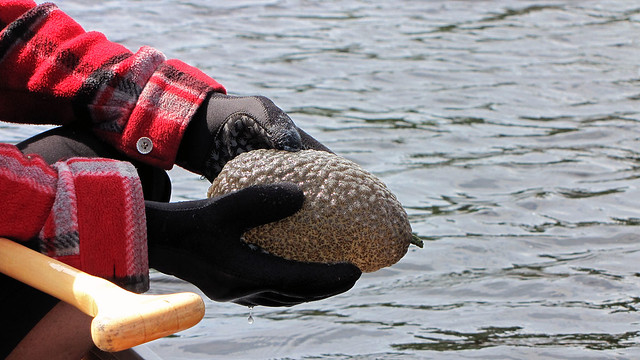




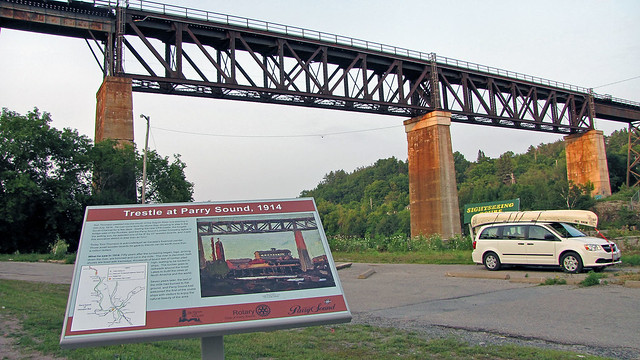


It must have been an awesome trip!
ReplyDelete